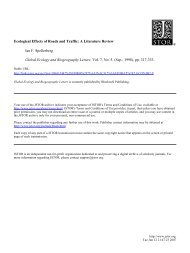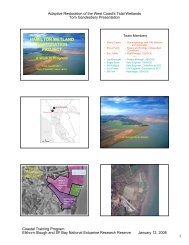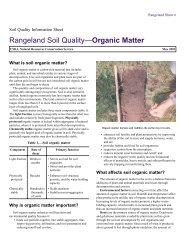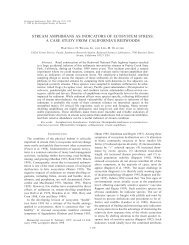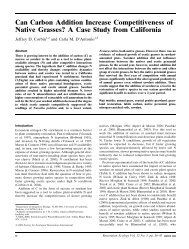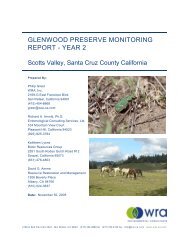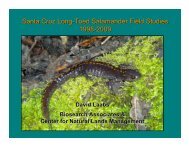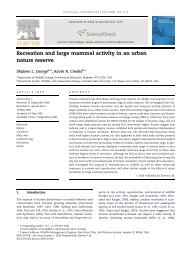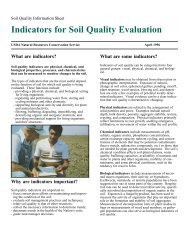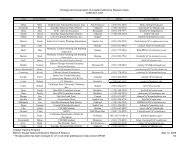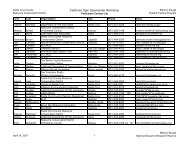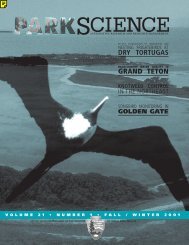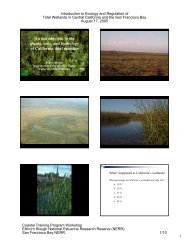DAVID J. ZIOLKOWSKI JR., KEITH L. PARDIECK AND JOHN R. SAUERfrom the Central region suggest that conditionsin that portion of the continent generally favoredstability more so than did conditions in the Westand East.Although the causes of such declines cannotbe divined from analysis of BBS data alone, it ispossible that extreme weather patterns during2007-2008 may have played a role. Mild El Niño– Southern Oscillation (ENSO) conditionsdeveloped in early Autumn 2006 (Arguez 2007),as indicated by a warming of the sea surface inthe eastern and central tropical Pacific Ocean(Larkin and Harrison 2002). These warmedwaters had cooled by early winter, changingwind patterns, and yielding relatively cool anddry winter conditions in the Western region, cooland wet conditions in the Central region, andwarm and dry conditions over much of theEastern region. The 2007 BBS field season metwith drier than average summer conditions inthe Western and Eastern BBS regions, including41% of the contiguous U.S. in moderate toextreme drought (Levinson and Lawrimore2008). Portions of the Central region, however,received record amounts of precipitation duringthis time. As the Pacific surface watersprogressed to a hypercooling phase in autumn2007 (Peterson and Baringer 2009), a strong LaNiña produced relatively cool winter conditionsin the Western and north-Central regions, warmand dry winter conditions in the southeast, andnotably warm and wet conditions in thenortheast. These conditions prevailed in the 2008BBS field season, with below normal summerprecipitation confined to the Western region andthe South-East.North American land bird population changeshave been correlated to earlier ENSO events(Morrison and Bolger 2002; Sillett et al. 2000;Nott et al. 2002) and previous BBS summaryreports have noted increases in Western birdpopulations and/or reductions in regionalmigrant groups in the subsequent 2-yr periods(Peterjohn et al. 1994, Pardieck and Sauer 2000,Pardieck and Sauer 2007). Comparison betweenEl Niño and La Niña is complicated given that‘typical’ weather patterns represent averageeffects, and actual effects can vary considerablydepending on the time of year of occurrence(Ropelewski and Halpert 1986). Also, othersubstantial atmospheric and oceanic phenomena,such as the Pacific/North American “teleconnection”pattern and the North AtlanticOscillation (Wallace and Gutzler 1981, Nott et al.2002), are likely influencing bird populations aswell. During 2007-2008, amongst the threeresident/migratory guilds, short-distancemigrants in the Western and Eastern regions andpermanent residents in the West experienced thegreatest proportion of declines. Neotropicalmigrants, on the other hand, were relativelystable across all regions, suggesting that winterweather patterns may have been an importantfactor contributing to declines in birds winteringin the United States. The relationship betweenland bird populations and large-scaleatmospheric and oceanic patterns deservesadditional study.The pattern of trends in the 2007-2008 periodwas similar to that seen in the 1966-2008 trends.Over the long-term, a species was 1.5 times morelikely to exhibit a significant decline than asignificant increase (Appendix 1). Life-historygroups during this time were also nearly threetimes more likely to contain a significantlygreater proportion of species with negativetrends (Figs. 1A-M). Only six of the 23 regionallife-history groups that deviated significantlyfrom 50% did so in the positive direction, and allsix occurred in the Central region.Overall, the tendency during the 2003-2008period was for all species to experiencesignificant range-wide population gains. All 13of the regional life-history groups with resultsthat deviated significantly from 50% during thisperiod were positively oriented. This is adeparture from the pattern seen in the previoustwo BBS summary reports, where mid-term andlong-term results demonstrated proportions ofincreasing species that were both similar to oneanother and lower than the 2-yr term results(Pardieck and Sauer 2000, Pardieck and Sauer2007). Whether or not the period of generaldecline during 2007-2008 reflects a meaningfulbiological correction following the 2003-2008growth spell is uncertain but worthy of furtherevaluation.Most grassland bird species have experiencedsteep long-term continent-wide declines andonly 5% of Eastern and 21% of Westernpopulations demonstrated positive growthduring 1966-2008 (Fig. 1B). The fact that the 6-yr[98]
NORTH AMERICAN BREEDING <strong>BIRD</strong> SURVEY 2003-2008and 2-yr percentages were generally larger thanthe long-term percentages in the Eastern andCentral regions is encouraging and, despitemany having credible intervals that span 50%,this is still indicative of progress and suggestivethat conditions may have improved f<strong>org</strong>rassland birds in recent years. Scrub/successional species also have declineddramatically in some areas so increases duringthe 6-yr and 2-yr intervals, relative to the longterm,were of special interest (Fig. 1D).Unfortunately, estimates during these intervalswere comparatively imprecise and additionalyears of favorable population change will beneeded before a reversal in the long-termdeclines would become apparent.Wetland and woodland species exhibited thegreatest overall number of increasing trendsamongst the habitat groupings (Figs. 1C, E).Within the 2003-2008 period of growth, theEastern region experienced the fewest number ofwetland-breeding population gains, but eventhis proportion was above 75%. Woodland birds,on the other hand, experienced their greatestproportional increases in the Eastern regionduring both the 6-yr (74%) and 2-yr (56%) terms,with fewer gains observed in the Central regionthan might have been expected. The survey-widelong-term trend of the wetland group wasslightly lower than that reported in the previousBBS summary, while the woodland group valuewas slightly higher.Detailed analyses of regional patterns ofpopulation trends within individual species arebeyond the scope of this paper. Species-specifictrend and relative abundance data, as well asadditional information regarding the survey areavailable at the North American Breeding BirdSurvey home page (http://www.pwrc.usgs.gov/BBS/).ACKNOWLEDGMENTSWe thank the thousands of volunteers whocontributed time, expertise, and energy to theBBS program during 2003-2008, as well as thosewho participated in earlier years. We are alsograteful for the careful review and constructivecomments provided by B. Peterjohn and S.Droege on the manuscript.LITERATURE CITEDAMERICAN ORNITHOLOGISTS’ UNION. 1998. Check-list ofNorth American Birds. 7th edition. AmericanOrnithologists’ Union, Washington, D.C.ARGUEZ, A. (ed.). 2007. State of the Climate in 2006.Bulletin of the American Meteorological Society88:S1-S135.BYSTRAK, D. 1981. The North American Breeding BirdSurvey. Pp. 34-41 in C.J. Ralph and J.M. Scott (eds.),Estimating Numbers of Terrestrial Birds. Studies inAvian Biology6.LARKIN, N.K., AND D.E. HARRISON. 2002. ENSO warm(El Niño) and cold (La Niña) event life cycles:Ocean surface anomaly patterns, their symmetries,asymmetries, and implications. Journal of Climate15:195–213.LEVINSON, D.H., AND J.H. LAWRIMORE (eds.). 2008. Stateof the Climate in 2007. Bulletin of the AmericanMeteorological Society 89:S1-S179.LINK, W.A., AND J.R. SAUER. 1998. Estimatingpopulation change from count data: application tothe North American Breeding Bird Survey.Ecological Applications 8:258-268.LINK, W.A., AND J.R. SAUER. 2002. A hierarchical modelof population change with application to CeruleanWarblers. Ecology 83:2832-2840.MORRISON, S.A., AND D.T. BOLGER. 2002. Variation in asparrow’s reproductive success with rainfall: foodand predator-mediated processes. Oecologia133:315–324.NOTT, P.M., D.F. DESANTE, R.B. SIEGEL, AND P. PYLE.2002. Influences of the El Nino/SouthernOscillation and the North Atlantic Oscillation onavian productivity in forests of the PacificNorthwest of North America. Global Ecology &Biogeography 11:333-342.PARDIECK, K.L., AND J.R. SAUER. 2000.The 1995-1999summary of the North American Breeding BirdSurvey. Bird Populations 5:30-48.PARDIECK, K.L., AND J.R. SAUER. 2007. The 1999-2003summary of the North American Breeding BirdSurvey. Bird Populations 8:28-45.PETERJOHN, B.G., AND J.R. SAUER. 1993. North AmericanBreeding Bird Survey annual summary 1990-1991.Bird Populations 1:1-15.PETERJOHN, B.G., J.R. SAUER, AND W.A. LINK. 1994. The1992 and 1993 summary of the North AmericanBreeding Bird Survey. Bird Populations 2:46-61.PETERJOHN, B.G., J.R. SAUER, AND W.A. LINK. 1996. The1994 and 1995 summary of the North AmericanBreeding Bird Survey. Bird Populations 3:48-66.PETERSON, T.C., AND M.O. BARINGER (eds.). 2009. Stateof the Climate in 2008. Bulletin of the AmericanMeteorological Society 90:S1-S196.[99]
- Page 1 and 2:
BIRD POPULATIONSA journal of global
- Page 3 and 4:
BIRD POPULATIONSA journal of global
- Page 6 and 7:
ROBERT L. WILKERSON AND RODNEY B. S
- Page 8 and 9:
ROBERT L. WILKERSON AND RODNEY B. S
- Page 10 and 11:
ROBERT L. WILKERSON AND RODNEY B. S
- Page 12 and 13:
ROBERT L. WILKERSON AND RODNEY B. S
- Page 14 and 15:
ROBERT L. WILKERSON AND RODNEY B. S
- Page 16 and 17:
ROBERT L. WILKERSON AND RODNEY B. S
- Page 18 and 19:
ROBERT L. WILKERSON AND RODNEY B. S
- Page 20 and 21:
ROBERT L. WILKERSON AND RODNEY B. S
- Page 22 and 23:
ROBERT L. WILKERSON AND RODNEY B. S
- Page 24 and 25:
ROBERT L. WILKERSON AND RODNEY B. S
- Page 26 and 27:
ROBERT L. WILKERSON AND RODNEY B. S
- Page 28 and 29:
ROBERT L. WILKERSON AND RODNEY B. S
- Page 30 and 31:
ROBERT L. WILKERSON AND RODNEY B. S
- Page 32 and 33:
ROBERT L. WILKERSON AND RODNEY B. S
- Page 34 and 35:
ROBERT L. WILKERSON AND RODNEY B. S
- Page 36 and 37:
ROBERT L. WILKERSON AND RODNEY B. S
- Page 38 and 39:
ROBERT L. WILKERSON AND RODNEY B. S
- Page 40 and 41:
NIRANJAN DAS AND SUJATA DEORIincluy
- Page 42 and 43:
NIRANJAN DAS AND SUJATA DEORIprovid
- Page 44 and 45:
NIRANJAN DAS AND SUJATA DEORIpopula
- Page 46 and 47:
NIRANJAN DAS AND SUJATA DEORITABLE
- Page 48 and 49:
NIRANJAN DAS AND SUJATA DEORITABLE
- Page 50 and 51: NIRANJAN DAS AND SUJATA DEORITABLE
- Page 52 and 53: NIRANJAN DAS AND SUJATA DEORITABLE
- Page 54 and 55: NIRANJAN DAS AND SUJATA DEORITABLE
- Page 56 and 57: NIRANJAN DAS AND SUJATA DEORITABLE
- Page 58 and 59: Bird Populations 10:56-64© The Ins
- Page 60 and 61: WETLAND BIRDS OF GHANAAvicennia afr
- Page 62 and 63: WETLAND BIRDS OF GHANATABLE 1. Data
- Page 64 and 65: WETLAND BIRDS OF GHANATABLE 2: Esti
- Page 66 and 67: WETLAND BIRDS OF GHANAATTUQUAYEFIO,
- Page 68 and 69: JANNIK HANSEN, LARS HOLST HANSEN, N
- Page 70 and 71: JANNIK HANSEN, LARS HOLST HANSEN, N
- Page 72 and 73: JANNIK HANSEN, LARS HOLST HANSEN, N
- Page 74 and 75: JANNIK HANSEN, LARS HOLST HANSEN, N
- Page 76 and 77: JANNIK HANSEN, LARS HOLST HANSEN, N
- Page 78 and 79: JANNIK HANSEN, LARS HOLST HANSEN, N
- Page 80 and 81: JANNIK HANSEN, LARS HOLST HANSEN, N
- Page 82 and 83: JANNIK HANSEN, LARS HOLST HANSEN, N
- Page 84 and 85: JANNIK HANSEN, LARS HOLST HANSEN, N
- Page 86 and 87: JANNIK HANSEN, LARS HOLST HANSEN, N
- Page 88 and 89: JANNIK HANSEN, LARS HOLST HANSEN, N
- Page 90 and 91: BIRD POPULATIONSA journal of global
- Page 92 and 93: Bird Populations 10:90-109© The In
- Page 94 and 95: DAVID J. ZIOLKOWSKI JR., KEITH L. P
- Page 96 and 97: DAVID J. ZIOLKOWSKI JR., KEITH L. P
- Page 98 and 99: DAVID J. ZIOLKOWSKI JR., KEITH L. P
- Page 102 and 103: DAVID J. ZIOLKOWSKI JR., KEITH L. P
- Page 104 and 105: DAVID J. ZIOLKOWSKI JR., KEITH L. P
- Page 106 and 107: DAVID J. ZIOLKOWSKI JR., KEITH L. P
- Page 108 and 109: DAVID J. ZIOLKOWSKI JR., KEITH L. P
- Page 110 and 111: DAVID J. ZIOLKOWSKI JR., KEITH L. P
- Page 112 and 113: Bird Populations 10:110-113© The I
- Page 114 and 115: THE 2007 AND 2008 NORTH AMERICAN BR
- Page 116 and 117: Bird Populations 10:114-124© The I
- Page 118 and 119: BREEDING BIRD CENSUS: 2007on the pl
- Page 120 and 121: BREEDING BIRD CENSUS: 2007May, with
- Page 122 and 123: BREEDING BIRD CENSUS: 2007Remarks:
- Page 124 and 125: BREEDING BIRD CENSUS: 200717. PITCH
- Page 126 and 127: BREEDING BIRD CENSUS: 2007+; Wester
- Page 128 and 129: BREEDING BIRD CENSUS: 2008gray Gnat
- Page 130 and 131: BREEDING BIRD CENSUS: 2008Warbler,
- Page 132 and 133: BREEDING BIRD CENSUS: 2008Source: W
- Page 134 and 135: BREEDING BIRD CENSUS: 2008Spotted T
- Page 136 and 137: BREEDING BIRD CENSUS: 2008precipita
- Page 138 and 139: Bird Populations 10© The Institute
- Page 140 and 141: IS AVIAN BREEDING SUCCESS WEATHERIN
- Page 142 and 143: IS AVIAN BREEDING SUCCESS WEATHERIN
- Page 144 and 145: DAVE LEECH AND CARL BARIMOREFlycatc
- Page 146 and 147: Bird Populations 10:143-145Reprinte
- Page 148 and 149: WOODPIGEON JOINS THE GARDEN PREMIER
- Page 150 and 151:
CHANGING THE GUARD AT UK BIRDTABLES
- Page 152 and 153:
Bird Populations is an entirely ele
- Page 154:
BIRD POPULATIONSA journal of global



